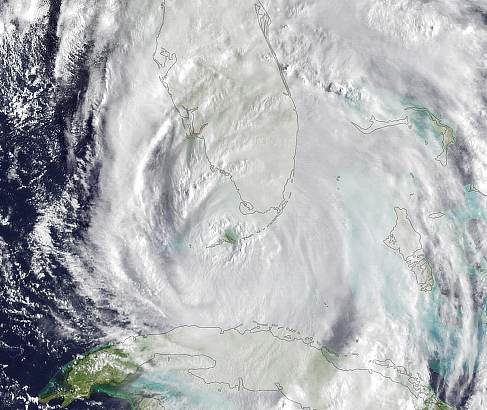Atlantic basin hurricane activity in 2018 is currently seen as most likely to be above normal by a range of scientists, as climate related factors point to seasonal activity being heightened with a greater chance of landfalls in the United States.
 Disclaimer first; it is very early to be predicting how active the 2018 Atlantic hurricane season will be, but there are signs in climatology and some forecasters are prepared to stick their necks out to give an early prognostication for the levels of hurricane activity we are likely to see.
Disclaimer first; it is very early to be predicting how active the 2018 Atlantic hurricane season will be, but there are signs in climatology and some forecasters are prepared to stick their necks out to give an early prognostication for the levels of hurricane activity we are likely to see.
First, Tropical Storm Risk, the forecasting cooperation between University College London and reinsurance broker Aon Benfield.
“TSR predicts Atlantic hurricane activity in 2018 will be slightly above the long-term norm and close to the last 10-year norm,” the organisations extended range forecast predicts, although noting that forecast skill this far out tends to be low.
The main predictor used in the TSR forecast is trade winds and how they influence storm formation and wind shear, to which it says that it, “Anticipates that July-September trade wind speed will be slightly weaker than normal and thus have an enhancing effect on Atlantic hurricane activity in 2018.”
At this early stage TSR is forecasting 15 named tropical storms, 7 hurricanes and 3 intense hurricanes, with an accumulated cyclone energy (ACE) of 117, for the 2018 Atlantic hurricane season. TSR gives a 47% chance that ACE will be above normal for the 2018 Atlantic basis season.
Next we turn to the Colorado State University tropical forecasting team of Philip Klotzbach and Michael Bell, who provide some qualitative information on how they foresee the 2018 Atlantic hurricane season panning out at this stage.
The Colorado team highlight two big questions that could influence 2018 hurricane activity, how or if the currently weak La Niña will develop and Atlantic Multidecadal Oscillation (AMO) trends.
The forecasters believe there are five possible scenarios, based on how much accumulated cyclone energy (ACE) the 2018 Atlantic hurricane season will produce, and gives the greatest chances to the most active, citing a 25% chance that ACE will be around 130 (with AMO above average and no El Niño occurring) for the season and a 25% chance it will be around 170 (with AMO being very strong and no El Niño occurring).
An ACE of 130 implies around 13 to 14 named tropical storms, 6 or 7 hurricanes and 2 or 3 major hurricanes, while ACE of 170 would be a very active season, with 14 to 17 named storms, 9 to 11 hurricanes and 4 or 5 major hurricanes.
The forecasters from Colorado State Uni appear to see a greater likelihood that El Niño does not develop in 2018, which is known to be a potential inhibitor of Atlantic hurricane activity levels.
Finally, a new forecasting team of scientists from the Climate Forecast Applications Network (CFAN) say that they predict an 80% probability of an above normal 2018 Atlantic hurricane season and a 90% chance of 1 or 2 U.S. hurricane landfalls.
The CFAN scientists have developed a brand new forecasting model for hurricanes, based on what they term as a, “breakthrough in understanding of the long-range impact of global climate dynamics on Atlantic hurricane activity.”
The CFAN scientists say the 2018 Atlantic hurricane season could have a total Accumulated Cyclone Energy (ACE) of 132 (+/-50) and 1.7 (+/-1.1) U.S. hurricane landfalls, figures that are near the averages for the active period since 1995.
CFAN’s scientists say that they have,” Identified precursors to the seasonal Atlantic hurricane activity with lead times as far out as 12 to 24 months. These early precursors involve systematic, repeating interactions among tropical Pacific sea surface patterns, atmospheric circulation patterns over the tropical North Atlantic and the Caribbean Sea, and stratospheric circulation patterns.”
So all three of these early forecasters, or qualitative commentators, on hurricane season activity are suggesting an above normal 2018 for the Atlantic basin.
For the reinsurance and insurance-linked securities (ILS) industry it is very early to begin looking to the tropics for 2018, but these early forecasts and discussions of climatology for the 2018 hurricane season are important and useful as companies look towards setting their expectations and hedging for the next hurricane year.
After the 2017 hurricane seasons losses, from Harvey, Irma and Maria, the reinsurance and ILS sector will be hoping for a quieter 2018.
Join us in New York in February 2018 for our next ILS conference
 View all of our Artemis Live video interviews and subscribe to our podcast.
View all of our Artemis Live video interviews and subscribe to our podcast.
All of our Artemis Live insurance-linked securities (ILS), catastrophe bonds and reinsurance video content and video interviews can be accessed online.
Our Artemis Live podcast can be subscribed to using the typical podcast services providers, including Apple, Google, Spotify and more.
































